Engineer Liability: Statutory, Tort, Contractual, Legal Case Analysis
VerifiedAdded on 2021/04/17
|5
|2048
|213
Report
AI Summary
This report provides a comprehensive analysis of engineer liability, exploring the multifaceted legal landscape encompassing statutory, tort, and contractual obligations. It delves into the different forms of liabilities an engineer may face, including those arising from statute, contract breaches, and tort law, particularly negligence claims. The report examines key legal concepts such as the doctrine of privity, the impact of cases like Beacon v. SOM, and the implications of the Spearin Doctrine. It discusses the engineer's duty to property owners, potential defenses against liability, and the importance of contractual agreements, including ownership of documents, patent rights, and confidentiality clauses. Furthermore, the report highlights the roles of both the engineer and the municipality in project management and the legal consequences of errors and omissions, supported by relevant case studies and legal precedents. The report concludes by emphasizing the importance of adhering to contractual terms, maintaining professional standards, and understanding the potential for economic losses and legal claims.
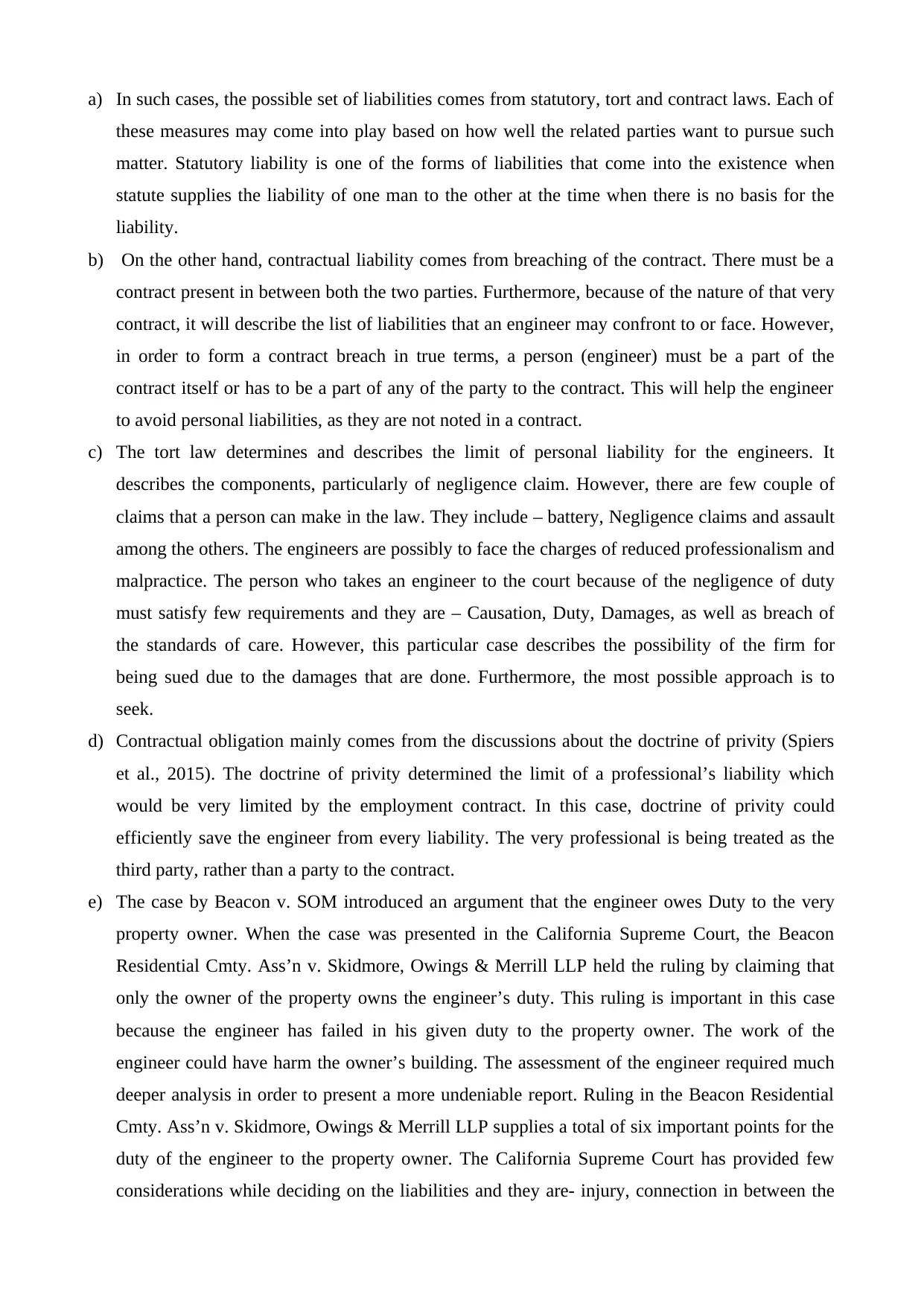
a) In such cases, the possible set of liabilities comes from statutory, tort and contract laws. Each of
these measures may come into play based on how well the related parties want to pursue such
matter. Statutory liability is one of the forms of liabilities that come into the existence when
statute supplies the liability of one man to the other at the time when there is no basis for the
liability.
b) On the other hand, contractual liability comes from breaching of the contract. There must be a
contract present in between both the two parties. Furthermore, because of the nature of that very
contract, it will describe the list of liabilities that an engineer may confront to or face. However,
in order to form a contract breach in true terms, a person (engineer) must be a part of the
contract itself or has to be a part of any of the party to the contract. This will help the engineer
to avoid personal liabilities, as they are not noted in a contract.
c) The tort law determines and describes the limit of personal liability for the engineers. It
describes the components, particularly of negligence claim. However, there are few couple of
claims that a person can make in the law. They include – battery, Negligence claims and assault
among the others. The engineers are possibly to face the charges of reduced professionalism and
malpractice. The person who takes an engineer to the court because of the negligence of duty
must satisfy few requirements and they are – Causation, Duty, Damages, as well as breach of
the standards of care. However, this particular case describes the possibility of the firm for
being sued due to the damages that are done. Furthermore, the most possible approach is to
seek.
d) Contractual obligation mainly comes from the discussions about the doctrine of privity (Spiers
et al., 2015). The doctrine of privity determined the limit of a professional’s liability which
would be very limited by the employment contract. In this case, doctrine of privity could
efficiently save the engineer from every liability. The very professional is being treated as the
third party, rather than a party to the contract.
e) The case by Beacon v. SOM introduced an argument that the engineer owes Duty to the very
property owner. When the case was presented in the California Supreme Court, the Beacon
Residential Cmty. Ass’n v. Skidmore, Owings & Merrill LLP held the ruling by claiming that
only the owner of the property owns the engineer’s duty. This ruling is important in this case
because the engineer has failed in his given duty to the property owner. The work of the
engineer could have harm the owner’s building. The assessment of the engineer required much
deeper analysis in order to present a more undeniable report. Ruling in the Beacon Residential
Cmty. Ass’n v. Skidmore, Owings & Merrill LLP supplies a total of six important points for the
duty of the engineer to the property owner. The California Supreme Court has provided few
considerations while deciding on the liabilities and they are- injury, connection in between the
these measures may come into play based on how well the related parties want to pursue such
matter. Statutory liability is one of the forms of liabilities that come into the existence when
statute supplies the liability of one man to the other at the time when there is no basis for the
liability.
b) On the other hand, contractual liability comes from breaching of the contract. There must be a
contract present in between both the two parties. Furthermore, because of the nature of that very
contract, it will describe the list of liabilities that an engineer may confront to or face. However,
in order to form a contract breach in true terms, a person (engineer) must be a part of the
contract itself or has to be a part of any of the party to the contract. This will help the engineer
to avoid personal liabilities, as they are not noted in a contract.
c) The tort law determines and describes the limit of personal liability for the engineers. It
describes the components, particularly of negligence claim. However, there are few couple of
claims that a person can make in the law. They include – battery, Negligence claims and assault
among the others. The engineers are possibly to face the charges of reduced professionalism and
malpractice. The person who takes an engineer to the court because of the negligence of duty
must satisfy few requirements and they are – Causation, Duty, Damages, as well as breach of
the standards of care. However, this particular case describes the possibility of the firm for
being sued due to the damages that are done. Furthermore, the most possible approach is to
seek.
d) Contractual obligation mainly comes from the discussions about the doctrine of privity (Spiers
et al., 2015). The doctrine of privity determined the limit of a professional’s liability which
would be very limited by the employment contract. In this case, doctrine of privity could
efficiently save the engineer from every liability. The very professional is being treated as the
third party, rather than a party to the contract.
e) The case by Beacon v. SOM introduced an argument that the engineer owes Duty to the very
property owner. When the case was presented in the California Supreme Court, the Beacon
Residential Cmty. Ass’n v. Skidmore, Owings & Merrill LLP held the ruling by claiming that
only the owner of the property owns the engineer’s duty. This ruling is important in this case
because the engineer has failed in his given duty to the property owner. The work of the
engineer could have harm the owner’s building. The assessment of the engineer required much
deeper analysis in order to present a more undeniable report. Ruling in the Beacon Residential
Cmty. Ass’n v. Skidmore, Owings & Merrill LLP supplies a total of six important points for the
duty of the engineer to the property owner. The California Supreme Court has provided few
considerations while deciding on the liabilities and they are- injury, connection in between the
Paraphrase This Document
Need a fresh take? Get an instant paraphrase of this document with our AI Paraphraser
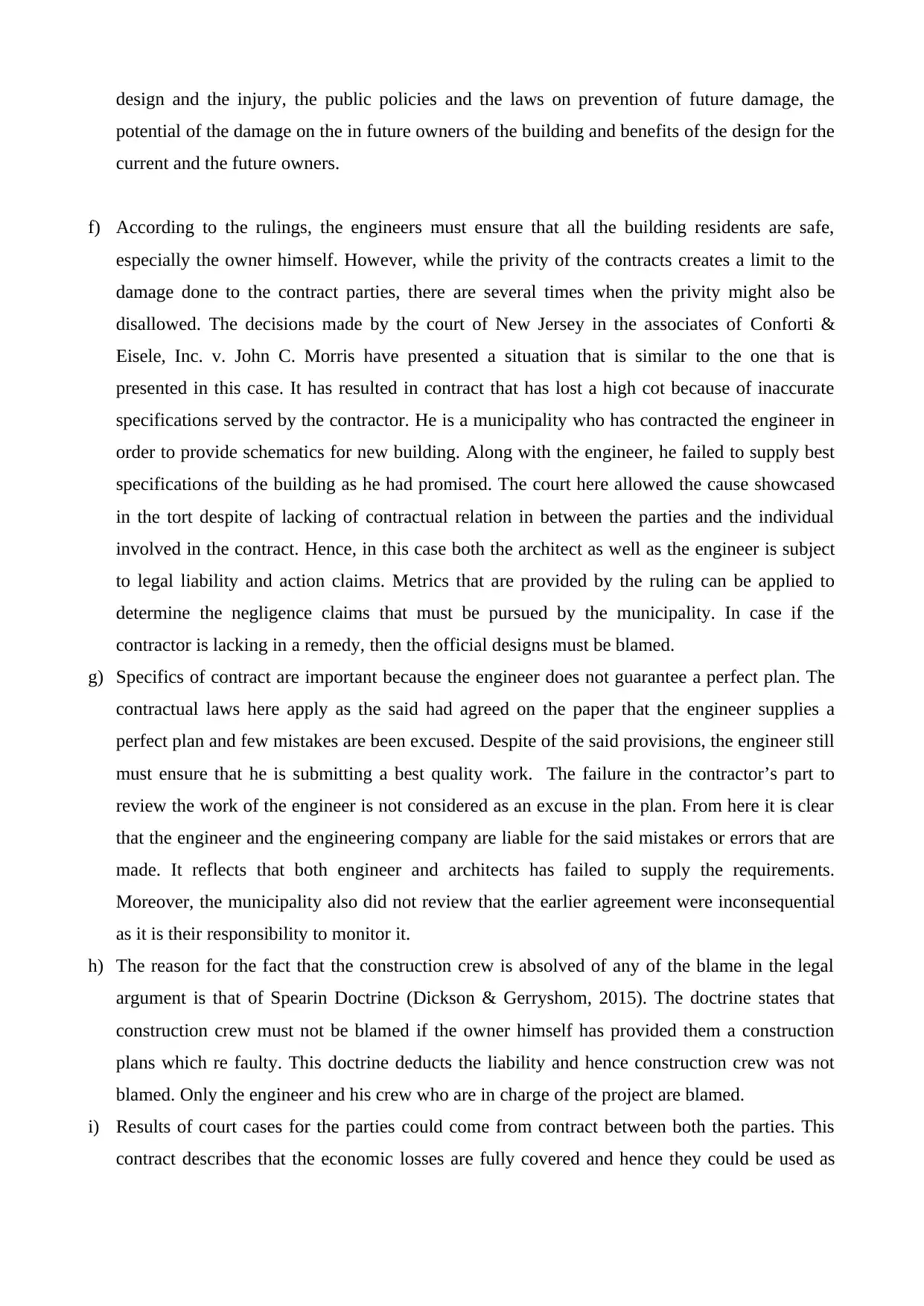
design and the injury, the public policies and the laws on prevention of future damage, the
potential of the damage on the in future owners of the building and benefits of the design for the
current and the future owners.
f) According to the rulings, the engineers must ensure that all the building residents are safe,
especially the owner himself. However, while the privity of the contracts creates a limit to the
damage done to the contract parties, there are several times when the privity might also be
disallowed. The decisions made by the court of New Jersey in the associates of Conforti &
Eisele, Inc. v. John C. Morris have presented a situation that is similar to the one that is
presented in this case. It has resulted in contract that has lost a high cot because of inaccurate
specifications served by the contractor. He is a municipality who has contracted the engineer in
order to provide schematics for new building. Along with the engineer, he failed to supply best
specifications of the building as he had promised. The court here allowed the cause showcased
in the tort despite of lacking of contractual relation in between the parties and the individual
involved in the contract. Hence, in this case both the architect as well as the engineer is subject
to legal liability and action claims. Metrics that are provided by the ruling can be applied to
determine the negligence claims that must be pursued by the municipality. In case if the
contractor is lacking in a remedy, then the official designs must be blamed.
g) Specifics of contract are important because the engineer does not guarantee a perfect plan. The
contractual laws here apply as the said had agreed on the paper that the engineer supplies a
perfect plan and few mistakes are been excused. Despite of the said provisions, the engineer still
must ensure that he is submitting a best quality work. The failure in the contractor’s part to
review the work of the engineer is not considered as an excuse in the plan. From here it is clear
that the engineer and the engineering company are liable for the said mistakes or errors that are
made. It reflects that both engineer and architects has failed to supply the requirements.
Moreover, the municipality also did not review that the earlier agreement were inconsequential
as it is their responsibility to monitor it.
h) The reason for the fact that the construction crew is absolved of any of the blame in the legal
argument is that of Spearin Doctrine (Dickson & Gerryshom, 2015). The doctrine states that
construction crew must not be blamed if the owner himself has provided them a construction
plans which re faulty. This doctrine deducts the liability and hence construction crew was not
blamed. Only the engineer and his crew who are in charge of the project are blamed.
i) Results of court cases for the parties could come from contract between both the parties. This
contract describes that the economic losses are fully covered and hence they could be used as
potential of the damage on the in future owners of the building and benefits of the design for the
current and the future owners.
f) According to the rulings, the engineers must ensure that all the building residents are safe,
especially the owner himself. However, while the privity of the contracts creates a limit to the
damage done to the contract parties, there are several times when the privity might also be
disallowed. The decisions made by the court of New Jersey in the associates of Conforti &
Eisele, Inc. v. John C. Morris have presented a situation that is similar to the one that is
presented in this case. It has resulted in contract that has lost a high cot because of inaccurate
specifications served by the contractor. He is a municipality who has contracted the engineer in
order to provide schematics for new building. Along with the engineer, he failed to supply best
specifications of the building as he had promised. The court here allowed the cause showcased
in the tort despite of lacking of contractual relation in between the parties and the individual
involved in the contract. Hence, in this case both the architect as well as the engineer is subject
to legal liability and action claims. Metrics that are provided by the ruling can be applied to
determine the negligence claims that must be pursued by the municipality. In case if the
contractor is lacking in a remedy, then the official designs must be blamed.
g) Specifics of contract are important because the engineer does not guarantee a perfect plan. The
contractual laws here apply as the said had agreed on the paper that the engineer supplies a
perfect plan and few mistakes are been excused. Despite of the said provisions, the engineer still
must ensure that he is submitting a best quality work. The failure in the contractor’s part to
review the work of the engineer is not considered as an excuse in the plan. From here it is clear
that the engineer and the engineering company are liable for the said mistakes or errors that are
made. It reflects that both engineer and architects has failed to supply the requirements.
Moreover, the municipality also did not review that the earlier agreement were inconsequential
as it is their responsibility to monitor it.
h) The reason for the fact that the construction crew is absolved of any of the blame in the legal
argument is that of Spearin Doctrine (Dickson & Gerryshom, 2015). The doctrine states that
construction crew must not be blamed if the owner himself has provided them a construction
plans which re faulty. This doctrine deducts the liability and hence construction crew was not
blamed. Only the engineer and his crew who are in charge of the project are blamed.
i) Results of court cases for the parties could come from contract between both the parties. This
contract describes that the economic losses are fully covered and hence they could be used as
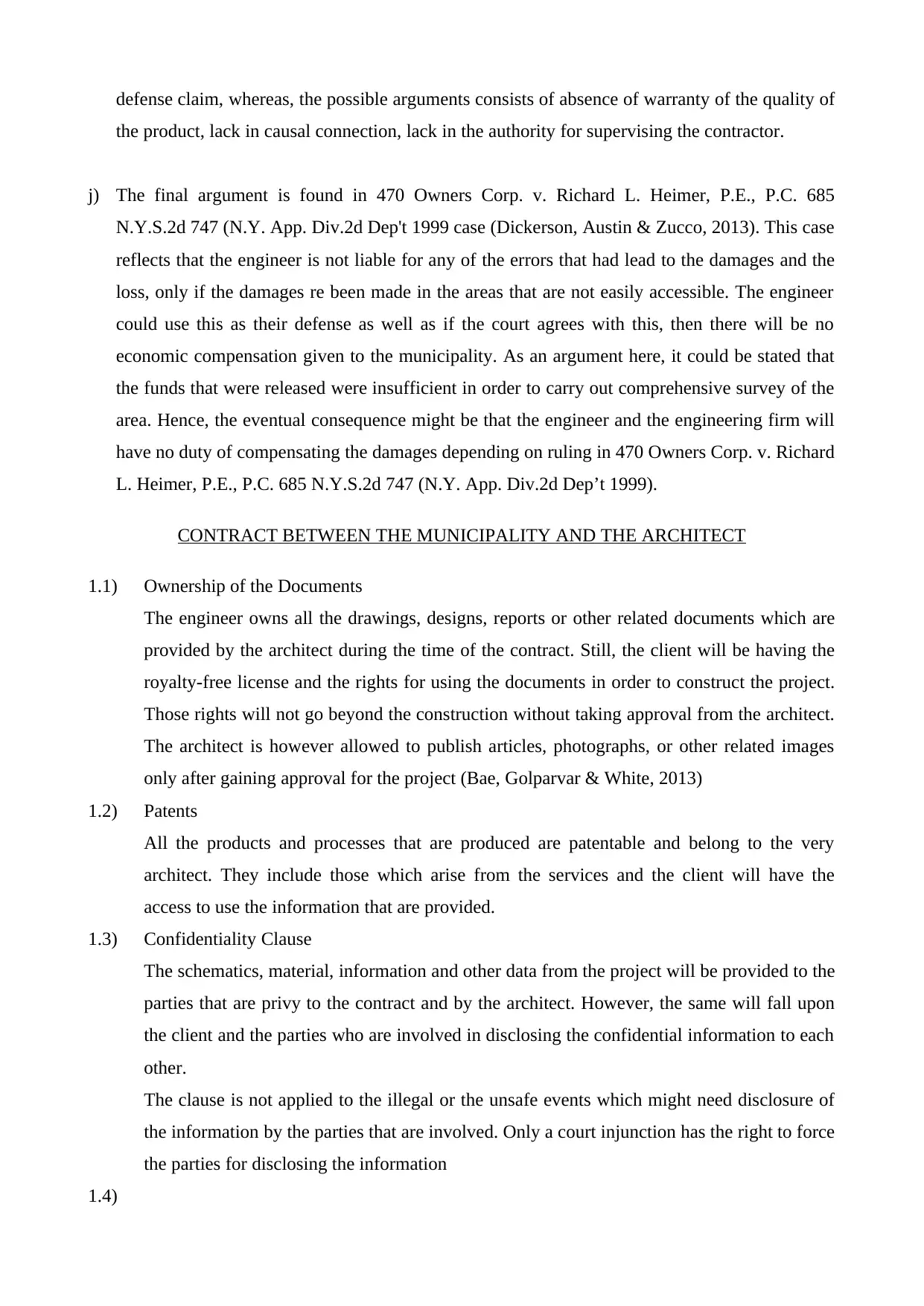
defense claim, whereas, the possible arguments consists of absence of warranty of the quality of
the product, lack in causal connection, lack in the authority for supervising the contractor.
j) The final argument is found in 470 Owners Corp. v. Richard L. Heimer, P.E., P.C. 685
N.Y.S.2d 747 (N.Y. App. Div.2d Dep't 1999 case (Dickerson, Austin & Zucco, 2013). This case
reflects that the engineer is not liable for any of the errors that had lead to the damages and the
loss, only if the damages re been made in the areas that are not easily accessible. The engineer
could use this as their defense as well as if the court agrees with this, then there will be no
economic compensation given to the municipality. As an argument here, it could be stated that
the funds that were released were insufficient in order to carry out comprehensive survey of the
area. Hence, the eventual consequence might be that the engineer and the engineering firm will
have no duty of compensating the damages depending on ruling in 470 Owners Corp. v. Richard
L. Heimer, P.E., P.C. 685 N.Y.S.2d 747 (N.Y. App. Div.2d Dep’t 1999).
CONTRACT BETWEEN THE MUNICIPALITY AND THE ARCHITECT
1.1) Ownership of the Documents
The engineer owns all the drawings, designs, reports or other related documents which are
provided by the architect during the time of the contract. Still, the client will be having the
royalty-free license and the rights for using the documents in order to construct the project.
Those rights will not go beyond the construction without taking approval from the architect.
The architect is however allowed to publish articles, photographs, or other related images
only after gaining approval for the project (Bae, Golparvar & White, 2013)
1.2) Patents
All the products and processes that are produced are patentable and belong to the very
architect. They include those which arise from the services and the client will have the
access to use the information that are provided.
1.3) Confidentiality Clause
The schematics, material, information and other data from the project will be provided to the
parties that are privy to the contract and by the architect. However, the same will fall upon
the client and the parties who are involved in disclosing the confidential information to each
other.
The clause is not applied to the illegal or the unsafe events which might need disclosure of
the information by the parties that are involved. Only a court injunction has the right to force
the parties for disclosing the information
1.4)
the product, lack in causal connection, lack in the authority for supervising the contractor.
j) The final argument is found in 470 Owners Corp. v. Richard L. Heimer, P.E., P.C. 685
N.Y.S.2d 747 (N.Y. App. Div.2d Dep't 1999 case (Dickerson, Austin & Zucco, 2013). This case
reflects that the engineer is not liable for any of the errors that had lead to the damages and the
loss, only if the damages re been made in the areas that are not easily accessible. The engineer
could use this as their defense as well as if the court agrees with this, then there will be no
economic compensation given to the municipality. As an argument here, it could be stated that
the funds that were released were insufficient in order to carry out comprehensive survey of the
area. Hence, the eventual consequence might be that the engineer and the engineering firm will
have no duty of compensating the damages depending on ruling in 470 Owners Corp. v. Richard
L. Heimer, P.E., P.C. 685 N.Y.S.2d 747 (N.Y. App. Div.2d Dep’t 1999).
CONTRACT BETWEEN THE MUNICIPALITY AND THE ARCHITECT
1.1) Ownership of the Documents
The engineer owns all the drawings, designs, reports or other related documents which are
provided by the architect during the time of the contract. Still, the client will be having the
royalty-free license and the rights for using the documents in order to construct the project.
Those rights will not go beyond the construction without taking approval from the architect.
The architect is however allowed to publish articles, photographs, or other related images
only after gaining approval for the project (Bae, Golparvar & White, 2013)
1.2) Patents
All the products and processes that are produced are patentable and belong to the very
architect. They include those which arise from the services and the client will have the
access to use the information that are provided.
1.3) Confidentiality Clause
The schematics, material, information and other data from the project will be provided to the
parties that are privy to the contract and by the architect. However, the same will fall upon
the client and the parties who are involved in disclosing the confidential information to each
other.
The clause is not applied to the illegal or the unsafe events which might need disclosure of
the information by the parties that are involved. Only a court injunction has the right to force
the parties for disclosing the information
1.4)
⊘ This is a preview!⊘
Do you want full access?
Subscribe today to unlock all pages.

Trusted by 1+ million students worldwide
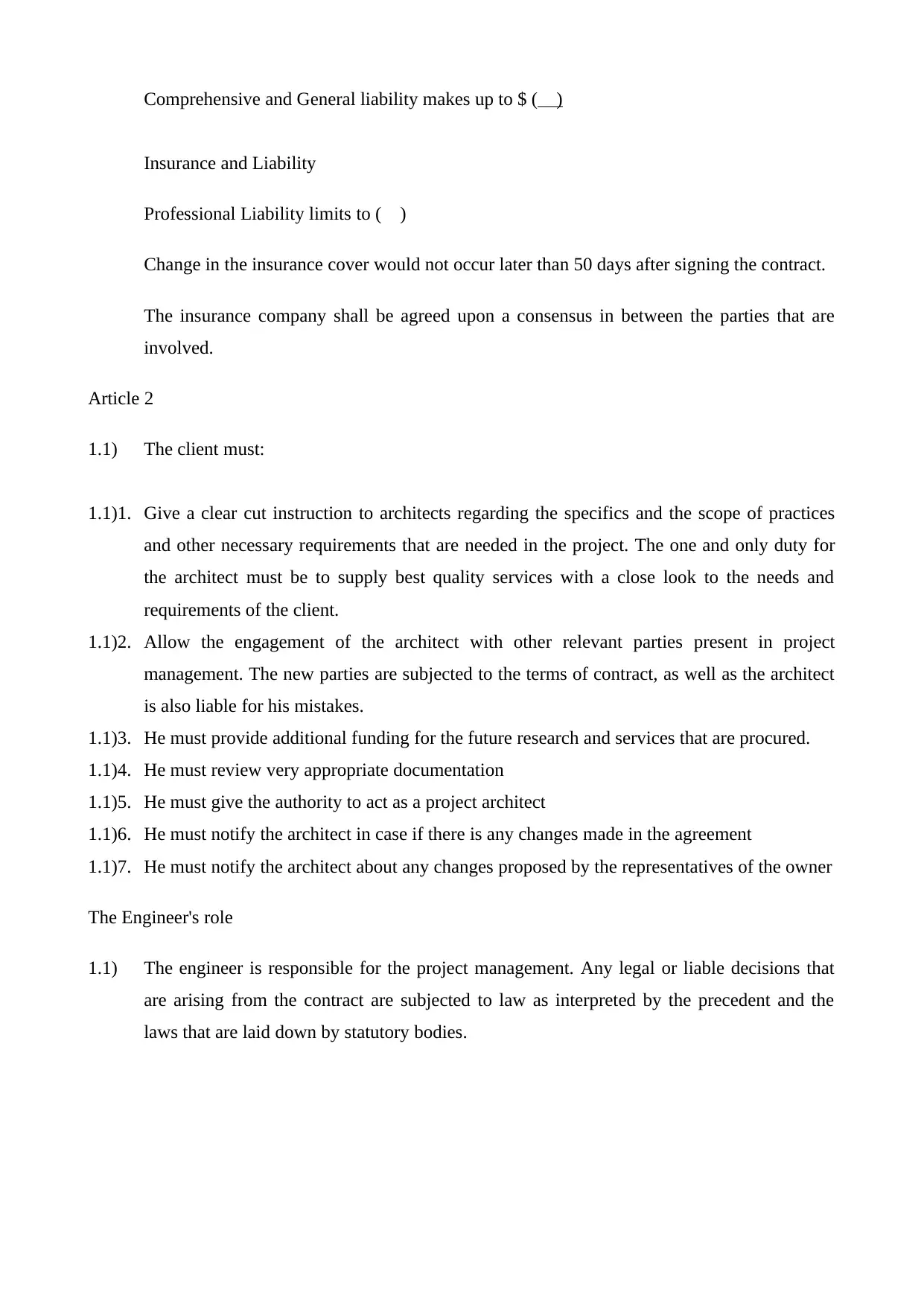
Comprehensive and General liability makes up to $ ( )
Insurance and Liability
Professional Liability limits to ( )
Change in the insurance cover would not occur later than 50 days after signing the contract.
The insurance company shall be agreed upon a consensus in between the parties that are
involved.
Article 2
1.1) The client must:
1.1)1. Give a clear cut instruction to architects regarding the specifics and the scope of practices
and other necessary requirements that are needed in the project. The one and only duty for
the architect must be to supply best quality services with a close look to the needs and
requirements of the client.
1.1)2. Allow the engagement of the architect with other relevant parties present in project
management. The new parties are subjected to the terms of contract, as well as the architect
is also liable for his mistakes.
1.1)3. He must provide additional funding for the future research and services that are procured.
1.1)4. He must review very appropriate documentation
1.1)5. He must give the authority to act as a project architect
1.1)6. He must notify the architect in case if there is any changes made in the agreement
1.1)7. He must notify the architect about any changes proposed by the representatives of the owner
The Engineer's role
1.1) The engineer is responsible for the project management. Any legal or liable decisions that
are arising from the contract are subjected to law as interpreted by the precedent and the
laws that are laid down by statutory bodies.
Insurance and Liability
Professional Liability limits to ( )
Change in the insurance cover would not occur later than 50 days after signing the contract.
The insurance company shall be agreed upon a consensus in between the parties that are
involved.
Article 2
1.1) The client must:
1.1)1. Give a clear cut instruction to architects regarding the specifics and the scope of practices
and other necessary requirements that are needed in the project. The one and only duty for
the architect must be to supply best quality services with a close look to the needs and
requirements of the client.
1.1)2. Allow the engagement of the architect with other relevant parties present in project
management. The new parties are subjected to the terms of contract, as well as the architect
is also liable for his mistakes.
1.1)3. He must provide additional funding for the future research and services that are procured.
1.1)4. He must review very appropriate documentation
1.1)5. He must give the authority to act as a project architect
1.1)6. He must notify the architect in case if there is any changes made in the agreement
1.1)7. He must notify the architect about any changes proposed by the representatives of the owner
The Engineer's role
1.1) The engineer is responsible for the project management. Any legal or liable decisions that
are arising from the contract are subjected to law as interpreted by the precedent and the
laws that are laid down by statutory bodies.
Paraphrase This Document
Need a fresh take? Get an instant paraphrase of this document with our AI Paraphraser
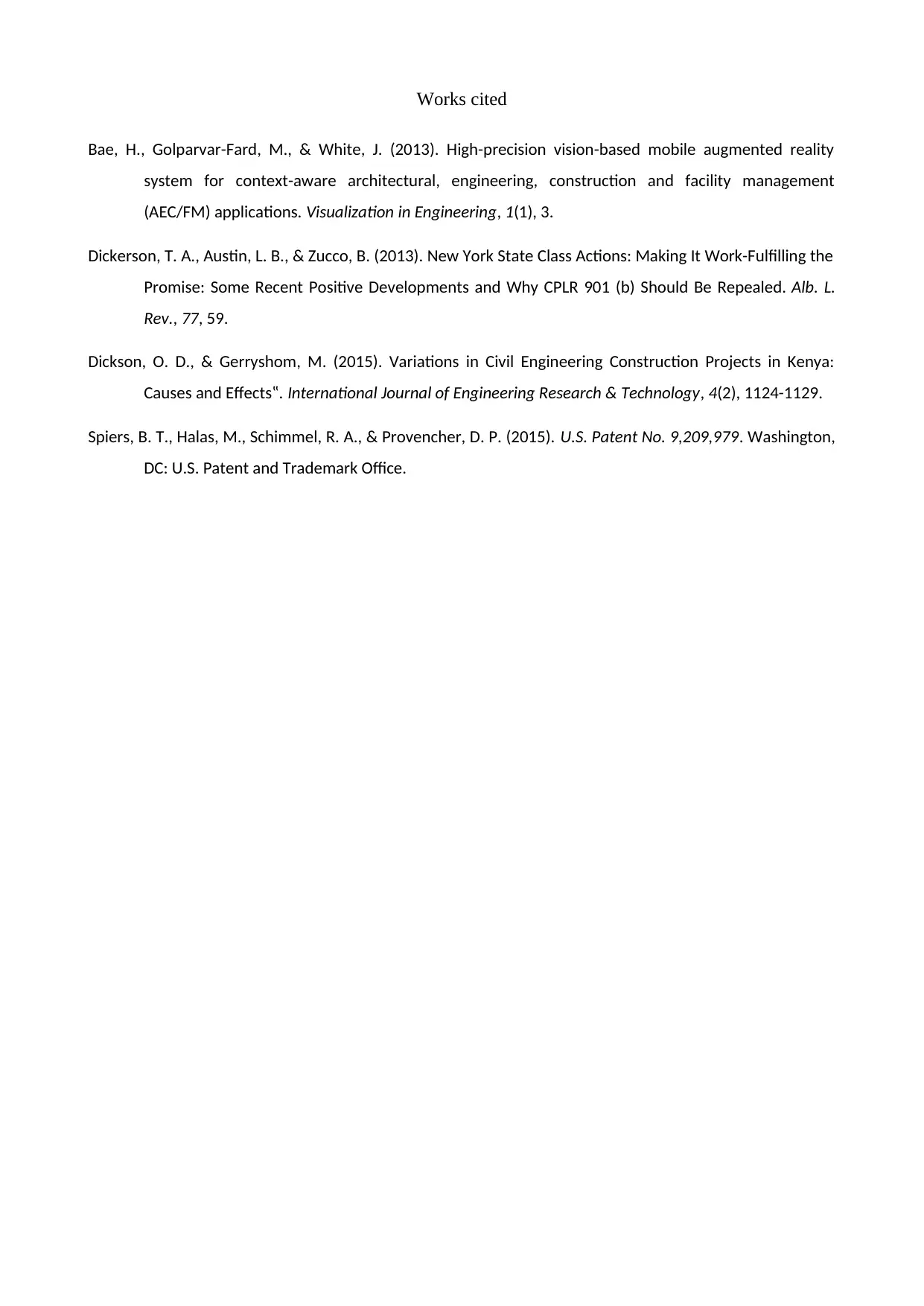
Works cited
Bae, H., Golparvar-Fard, M., & White, J. (2013). High-precision vision-based mobile augmented reality
system for context-aware architectural, engineering, construction and facility management
(AEC/FM) applications. Visualization in Engineering, 1(1), 3.
Dickerson, T. A., Austin, L. B., & Zucco, B. (2013). New York State Class Actions: Making It Work-Fulfilling the
Promise: Some Recent Positive Developments and Why CPLR 901 (b) Should Be Repealed. Alb. L.
Rev., 77, 59.
Dickson, O. D., & Gerryshom, M. (2015). Variations in Civil Engineering Construction Projects in Kenya:
Causes and Effects‟. International Journal of Engineering Research & Technology, 4(2), 1124-1129.
Spiers, B. T., Halas, M., Schimmel, R. A., & Provencher, D. P. (2015). U.S. Patent No. 9,209,979. Washington,
DC: U.S. Patent and Trademark Office.
Bae, H., Golparvar-Fard, M., & White, J. (2013). High-precision vision-based mobile augmented reality
system for context-aware architectural, engineering, construction and facility management
(AEC/FM) applications. Visualization in Engineering, 1(1), 3.
Dickerson, T. A., Austin, L. B., & Zucco, B. (2013). New York State Class Actions: Making It Work-Fulfilling the
Promise: Some Recent Positive Developments and Why CPLR 901 (b) Should Be Repealed. Alb. L.
Rev., 77, 59.
Dickson, O. D., & Gerryshom, M. (2015). Variations in Civil Engineering Construction Projects in Kenya:
Causes and Effects‟. International Journal of Engineering Research & Technology, 4(2), 1124-1129.
Spiers, B. T., Halas, M., Schimmel, R. A., & Provencher, D. P. (2015). U.S. Patent No. 9,209,979. Washington,
DC: U.S. Patent and Trademark Office.
1 out of 5
Related Documents
Your All-in-One AI-Powered Toolkit for Academic Success.
+13062052269
info@desklib.com
Available 24*7 on WhatsApp / Email
![[object Object]](/_next/static/media/star-bottom.7253800d.svg)
Unlock your academic potential
Copyright © 2020–2025 A2Z Services. All Rights Reserved. Developed and managed by ZUCOL.





